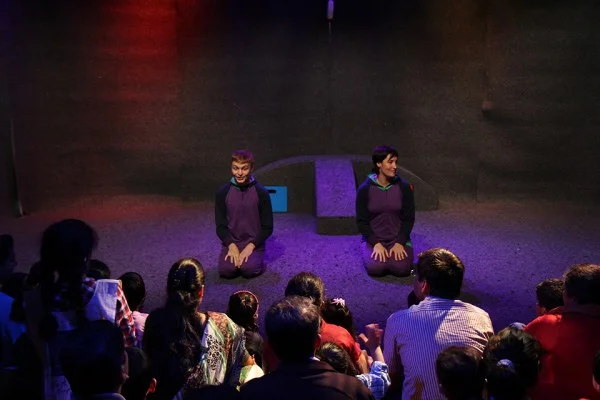Working in early childhood education centres is integral to our work at Imaginary Theatre. We utilise these dynamic spaces as a source of inspiration, research, and consultation in creating performances for early years audiences. Over the past years, we have been thinking a lot about what we have learnt from children in these settings, and in particular, about our non-verbal ‘first language’ which is so clearly visible in the play of young children (by non-verbal we simply mean without structured speech, and acknowledge that babies and young children have plenty of verbal sounds they use to communicate prior to this stage).
“Play is the highest form of research” said Albert Einstein, and we happen to agree.
We believe play is by nature a creative form, and the processes and outcomes of play are equally valuable in their own right. Children are born with this innate ability to play, to create, to explore and experiment, and in this sense are born artists.
In particular the idea of a non-verbal first language is something that we find particularly interesting in a theatre context. Our 2009 research initiative 'Play Project' was the starting point for our explorations in this area. We were interested in immersing ourselves in children’s play, to learn from children as experts in this form.
Our approach was this, to work in the everyday setting of children in three different early years settings over 100 hours. Once we had been accepted as ‘players’ in the group, we would use our own creativity to provoke and resource new play through the insertion of various outside stimuli that would transform the play space in some way, and lead to new explorations. The results were amazing, with children exhibiting enriched play behaviours, sparked by this new stimulus, and taking on new and complex dimensions. We were inspired by the raw creativity that bubbles away in the playground each and every day.
Through extensive documentation, observations and reflections (which we compiled on a closed project wiki), we were able to develop ‘Playscapes’, our own system for describing and analysing children's play. This system includes the types of play we witnessed, the characteristics of ‘players’ we encountered, and the aesthetic dimensions we saw play take on.
What is really interesting for me is how we have now applied this to our knowledge of how young children perceive and respond to theatre.
For myself and the other artists on board, rediscovering the joy of children's play was an astonishing thing to happen. Although we as adults cannot play like children, we can certainly free ourselves from the rigidity of the adult world through this process. Also, and this is the most interesting part, we were able to re-acquaint ourselves with this 'first language', the highly complex non-verbal communication that play utilises.
What has been incredibly valuable is that this process has allowed us to create theatre for children that utilises their own language and creative form, play, as the primary mode of communication. By using what we know about play behaviours and how they effect relationships, interaction, and personal development, we think we have been able to develop a performance language that communicates with children in a really authentic way, and results in audiences being able to follow quite complex sequences, leaving them truly engrossed in each moment.
Also interesting for us is something that has happened in testing our theory whilst touring our productions internationally. For example, our production for 2-5 year olds, 'Look', has now played in Australia, South Korea and India. What's interesting about this is that the type of engagement we see from children is almost identical despite the vast cultural differences of these audiences. It seems to us that play is a language that translates across culture and place.
This all makes perfect sense, when we consider the wealth of research emerging in the area of early-childhood development and psychology.
Very recent research from the University of Warwick on how children perceive and engage in non-verbal communication has supported our findings, showing that young children use ‘language like’ structures in interpreting and participating in non-verbal communication
Also underpinning this is research from philosopher and psychologist Alison Gopnik, who suggests that young children are actually emotionally smarter, more creative and compassionate than adults can ever be.
In the Huffington Post, Lauren Gunderson recently shared some insights from her friend Bill English of the San Francisco Playhouse,who has said that "Theatre is like a gym for empathy. It's where we can go to build up the muscles of compassion, to practice listening and understanding and engaging with people that are not just like ourselves. We practice sitting down, paying attention and learning from other people's actions. We practice caring.”
If play is our first language, and our first creative form, then anywhere that play takes place whether it be the classroom, the theatre, or the backyard could also be described as a gym for empathy, and so much more. It's these spaces where children grow and develop, where they learn about themselves, about each other, and about the rich dynamic and potential of human relationships. Not only this, but as we found, these gyms are also place for adults to re-discover all this for themselves.
Thom Browning is the Associate Artistic Director of Imaginary Theatre





